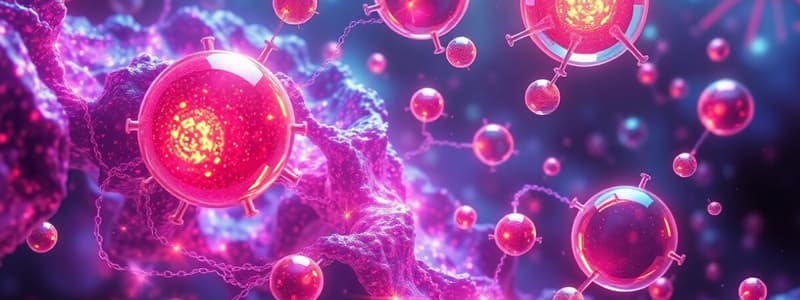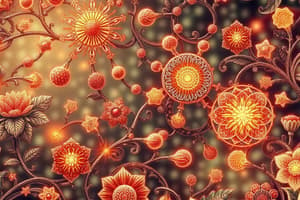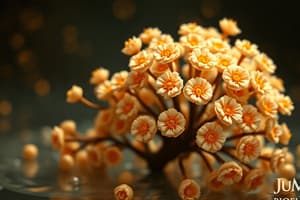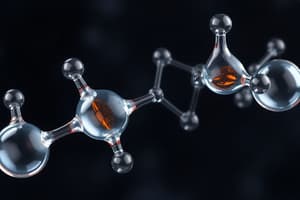Podcast
Questions and Answers
Which of the following is NOT a primary bioelement?
Which of the following is NOT a primary bioelement?
- Hydrogen (H)
- Nitrogen (N)
- Carbon (C)
- Calcium (Ca) (correct)
What property of water allows it to moderate temperature in coastal areas?
What property of water allows it to moderate temperature in coastal areas?
- High heat of vaporization
- High specific heat (correct)
- Low specific heat
- Low heat of vaporization
Which property of water is demonstrated when water molecules are attracted to each other?
Which property of water is demonstrated when water molecules are attracted to each other?
- Density anomaly
- Adhesion
- Cohesion (correct)
- Solvent capability
Why does ice float on liquid water?
Why does ice float on liquid water?
What is the primary function of precipitated mineral salts in organisms?
What is the primary function of precipitated mineral salts in organisms?
How do buffer solutions help maintain homeostasis in biological systems?
How do buffer solutions help maintain homeostasis in biological systems?
What happens to a red blood cell when placed in a hypertonic solution?
What happens to a red blood cell when placed in a hypertonic solution?
Which of the following is the role of bicarbonate buffer system during hyperventilation?
Which of the following is the role of bicarbonate buffer system during hyperventilation?
What is the significance of cells being turgid?
What is the significance of cells being turgid?
Which of the following is the principle behind using salt to preserve food?
Which of the following is the principle behind using salt to preserve food?
Which process involves the movement of water across a semipermeable membrane from an area of lower solute concentration to an area of higher solute concentration?
Which process involves the movement of water across a semipermeable membrane from an area of lower solute concentration to an area of higher solute concentration?
What determines whether a substance will pass through a semipermeable membrane in osmosis?
What determines whether a substance will pass through a semipermeable membrane in osmosis?
What type of bonds does Carbon form?
What type of bonds does Carbon form?
What is the term for mineral salts performing functions through its ions?
What is the term for mineral salts performing functions through its ions?
What is the name of the functional group that has the formula -NH₂?
What is the name of the functional group that has the formula -NH₂?
Which of the following describes the cellular environment when a red blood cell is in an isotonic solution?
Which of the following describes the cellular environment when a red blood cell is in an isotonic solution?
What is the ultimate effect of salting food?
What is the ultimate effect of salting food?
Which of the following bioelements is present in a lower quantity?
Which of the following bioelements is present in a lower quantity?
Which structural feature of water molecules explains the high cohesion between the water molecules?
Which structural feature of water molecules explains the high cohesion between the water molecules?
What causes alkali soils?
What causes alkali soils?
Flashcards
Primary Bioelements
Primary Bioelements
C, H, O, N, P, S. They constitute most of the organic matter.
Secondary Bioelements
Secondary Bioelements
Ca, Na, K, Cl, Mg. They play fundamental roles in the functioning of living beings.
Oligoelements
Oligoelements
Fe, Zn, I, Li, Si, F, Co, Mn. They are indispensable for physiological processes, even in small amounts.
Bioelements Characteristics
Bioelements Characteristics
Signup and view all the flashcards
Hydroxyl Group
Hydroxyl Group
Signup and view all the flashcards
Carbonyl Group (Ketone)
Carbonyl Group (Ketone)
Signup and view all the flashcards
Carbonyl Group (Aldehyde)
Carbonyl Group (Aldehyde)
Signup and view all the flashcards
Amino Group
Amino Group
Signup and view all the flashcards
Water (H₂O)
Water (H₂O)
Signup and view all the flashcards
Water as a Dipole
Water as a Dipole
Signup and view all the flashcards
Water's Cohesion
Water's Cohesion
Signup and view all the flashcards
Surface Tension of Water
Surface Tension of Water
Signup and view all the flashcards
Water's High Specific Heat
Water's High Specific Heat
Signup and view all the flashcards
Water's High Heat of Vaporization
Water's High Heat of Vaporization
Signup and view all the flashcards
Lower Density of Ice
Lower Density of Ice
Signup and view all the flashcards
Water as a Solvent
Water as a Solvent
Signup and view all the flashcards
Adhesion of Water
Adhesion of Water
Signup and view all the flashcards
Functions of Water
Functions of Water
Signup and view all the flashcards
Precipitated Mineral Salts
Precipitated Mineral Salts
Signup and view all the flashcards
Dissolved Mineral Salts
Dissolved Mineral Salts
Signup and view all the flashcards
Study Notes
Bioelements and Biomolecules
- For the formation of organic biomolecules, inorganic substances are necessary.
- Primary bioelements include Carbon, Hydrogen, Oxygen, Nitrogen, Phosphorus, and Sulfur, making up approximately 96% of organic matter.
- Secondary bioelements like Calcium, Sodium, Potassium, Chlorine, and Magnesium constitute 2-4% and play a fundamental role in living beings' functioning.
- Oligoelements such as Iron, Zinc, Iodine, Lithium, Silicon, Fluorine, Cobalt, and Manganese make up less than 0.1% but are indispensable for physiological processes.
- Bioelements are elements present in living matter and are non-metallic.
- They have a small atomic mass and a greater tendency to form covalent bonds.
- Organic molecules contain functional groups such as hydroxyl (-OH), carbonyl (ketone, -C=O), carbonyl (aldehyde, -C=O H), amino (-NH2), and carboxyl (-CO).
Water (H₂O)
- Water can be found in three forms in the organism: circulating, interstitial (between cells), and intracellular (cytosol).
- The water molecule behaves as a dipole, possessing two poles with different charges.
- Water would be a gas at room temperature if not for its molecular mass; water's hydrogen bonds form a network that explains its liquid state at ambient temperatures.
- Carbon is based on carbon chemistry and can make 4 bonds.
- Being covalent, it forms stable structures distributed in a three-dimensional form, leading to diverse types of structures (linear, cyclic, branched).
Physical-Chemical Properties of Water
- High cohesion force between its molecules due to hydrogen bonds keeps water molecules together.
- High surface tension results from the resistance of molecules to separation.
- High specific heat means much energy is needed to raise the temperature of a mass of water by 1°C.
- High vaporization heat, meaning much energy is required to convert liquid water into vapor, making sweat an efficient coolant.
- Water has lower density in solid form (ice) than in liquid form; ice floats in water, and water has a maximum density at 4°C.
- Water has great solvent capacity due to its polarity for iconic compounds
- Strong adhesive force causes water molecules' tendency to stick to the walls of vessels, contributing to phenomena like sap ascent in plants.
Functions of Water
- Transportation, such as in blood.
- Dissolution, as biochemical reactions occur in an aqueous medium.
- Structural component of cells.
- Capillary action.
- Thermoregulation.
- Ecological role, such as life under ice.
- Acts as a shock absorber, like synovial fluid.
Mineral Salts
- Precipitated salts form structural components like bones and shells (e.g., CaCO3).
- Dissolved salts (ions) perform various functions.
- Nerve impulse transmission depends on Na+ and K+.
- Muscle contraction depends on Ca2+.
- Metabolic reactions and salinity
- Buffer for biological processes.
- Mg2+ and Na+ facilitate the transport of O2 and CO2, and Mg2+ is part of chlorophyll.
- Neurotransmitter release depends on Ca2+ at the axon’s end.
- pH = -log[H+] measures the alkalinity or acidity of a solution, depending on [H+].
- Biological mediums have their buffer solutions, and intracellular fluid should maintain its pH stable(homeostasis) .
- Blood has a pH between 7.35-7.45, while intracellular fluid's pH ranges from 6.4-7.4.
- Buffer solutions containing dissolved mineral salts can cushion small pH changes internally.
- The phosphate buffer in the cell's interior maintains a stable intracellular pH.
Bicarbonate Buffer
- Bicarbonate buffer (in blood) involves CO2 + H2O being interconverted to H2CO3, which then forms HCO3- + H+.
- During hyperventilation, a decrease in [CO2] in the blood causes alkalosis. Th buffer attempts to compensate by producing CO2.
- Hypoventilation leads to a rise of O2.
Diffusion and Osmosis
- Diffusion and osmosis are very important for cells.
- Diffusion distributes particles homogeneously from a high concentration to a lower concentration.
- Gases pass through diffusion within cells.
- Osmosis occurs across semipermeable membranes allowing the passage of solvents to equalize concentration.
- Solute cannot pass; the solvent moves in osmosis to balance concentrations.
- A red blood cell in an isotonic medium is in equilibrium.
- In a Hypertonic Environment water exits the cell, leading to plasmolysis.
- In a Hypotonic Environment water enters the cell, potentially causing lysis and finally the globule will burst
Turgidity
- Turgidity needs to kept at the right levels, not to much
- For Flowers can occur the the cells are bloated, and hold for a bit longer
- Eventually the flowers decay, and die due to lack of nutrients
Food Preservation Techniques
- Adding salt can kill microoganisms. This is achived by dehydrating the microganisms
- Excess sugar can kill microorganism, due to the hypertonic enviroment and dehrdatation
Studying That Suits You
Use AI to generate personalized quizzes and flashcards to suit your learning preferences.



